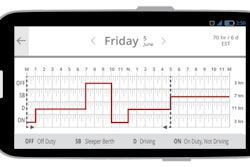
One last time: tonight’s the night the federal rules regarding changes to truck drivers’ hours of service change.
The switch officially takes place at 12:01 a.m. EDT Tuesday, Sept. 29.
As our colleague, James Jaillet, executive editor for trucking, reports, the rules adjustments “will make changes to the 30-minute break requirement that could, many days, render the break somewhat of a moot requirement. At the very least, drivers will be able to fulfill the 30-minute break requirement in a much more utilitarian way within their daily work schedules than current regulations allow.”
Jaillet explains in his article for Commercial Carrier Journal:
Under the regs instituted in 2013, drivers have been required to take a break of 30 minutes long — either in off-duty or sleeper berth status — within their first eight hours on-duty. The off-duty or sleeper berth component is significant since it prohibits drivers from doing any on-duty functions like fueling or minor maintenance.
The new regs change that to, simply, drivers can’t drive more than eight hours without taking at least a 30-minute break, which can be spent in off-duty mode, sleeper-berth or on-duty/not-driving status. That’s much more lenient than a 30-minute, off-duty break within the first eight on-duty hours.
Read Jaillet’s complete article here.
The Federal Motor Carrier Safety Administration’s hours of service changes also:
- modifies the sleeper-berth exception to allow drivers to split their 10-hour off-duty period into windows of seven hours and three hours, in addition to the existing eight-hour, two-hour option. It also adds the shorter period in any split off-duty will pause the rolling on-duty clock
- allows drivers to extend their drive-time limit and their on-duty window by two hours if they encounter adverse weather conditions or traffic congestion
- changes the short-haul exception available to some commercial drivers by lengthening their maximum on‑duty period from 12 to 14 hours and extending the distance limit within which the driver may operate from 100 air miles to 150 air miles









